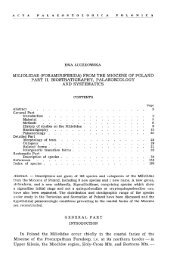The skull of Velociraptor - Acta Palaeontologica Polonica
The skull of Velociraptor - Acta Palaeontologica Polonica
The skull of Velociraptor - Acta Palaeontologica Polonica
Create successful ePaper yourself
Turn your PDF publications into a flip-book with our unique Google optimized e-Paper software.
ACTA PALAEONTOLOGICA POLONICA (44) (2) 215<br />
nate, or doubtful, dromaeosaurid remains have been also reported (see: Weishampel<br />
1990) from the Lower or Upper Cretaceous deposits <strong>of</strong> the United States (Utah, Colo-<br />
rado, New Mexico, Texas), Mexico (Estado de Baja California Norte, Estado de<br />
Coahuila), Uzbekistan and Kazakhstan (Nessov 1995). Dromaeosaurid or dromaeo-<br />
saurid-like teeth, with denticles differing in size between the mesial and distal carinae,<br />
have been reported from the presumably Lower Cretaceous deposits (Xinminbao For-<br />
mation) <strong>of</strong> the Gansu Province in China (Dong 1997). <strong>The</strong>se may constitute the earliest<br />
dromaeosaurid record, not supported as far by any bone material. Supposedly dro-<br />
maeosaurid teeth, the more precise taxonomic assignment <strong>of</strong> which is at the moment<br />
impossible, have been found also in the European Upper Cretaceous deposits (France:<br />
Buffetaut et al. 1986; Romania: Grigorescu 1984; Csiki & Grigorescu 1998; Spain:<br />
Sanz & Frances in: Pol et al. 1992). As demonstrated by Howse & Milner (1993), the<br />
holotype sacrum <strong>of</strong> Ornithodesmus cluniculus Seeley, 1887 (England), determined by<br />
Seeley (1901) as belonging to a pterosaur, represents in fact a theropod. Contrary to<br />
Howse & Milner, who assigned 0. cluniculus to the Troodontidae, Norell & Mako-<br />
vicky (1997), believe it should be placed within the dromaeosaurids.<br />
Some small dromaeosaurid teeth have been reported from Alaska (Clemens &<br />
Nelms 1993) and Sudan (Rauhut & Werner 1995). <strong>The</strong> Sudan teeth are accompanied<br />
by some pedal phalanges and unguals; these remains constitute the first Gondwanan<br />
record <strong>of</strong> the Dromaeosauridae.<br />
<strong>The</strong> stratigraphically oldest so far described dromaeosaurid species are known<br />
from North America (and from Europe, if the Barremian 0. cluniculus is a dromaeo-<br />
saurid, as suggested by Norell & Makovicky 1997). <strong>The</strong>y are: the Barremian (Cedar<br />
Mountain Formation) Utahraptor ostrommaysorum Kirkland et al., 1 993, which is<br />
based upon fragmentary <strong>skull</strong> and postcranial material, and the Aptian-Albian (Clo-<br />
verly Formation) Deinonychus antirrhopus Ostrom, 1969. <strong>Velociraptor</strong> mongoliensis<br />
Osborn, 1924 from Asia is younger, being found in deposits <strong>of</strong> the ?early and ?late<br />
Campanian age (Djadokhta, Bayan Mandahu and Barun Goyot formations, and proba-<br />
bly also the Minhe Formation). Two North American species, Dromaeosaurus alber-<br />
tensis Matthew & Brown, 1922 and Saurornitholestes langstoni Sues, 1978 (both from<br />
the late Campanian Dinosaur Park Formation, see Eberth & Hamblin 1993), are<br />
roughly contemporaneous with V mongoliensis, while the poorly known Mongolian<br />
Adasaurus mongoliensis Barsbold, 1983 (the ?early Maastrichtian Bugeen Tsav beds;<br />
contemporaneous with the tyrannosaurid Tarbosaurus bataar) represents the stratigra-<br />
phically youngest dromaeosaurid so far known. If the determination <strong>of</strong> the strati-<br />
graphic age <strong>of</strong> the Bugeen Tsav beds is correct, the Dromaeosauridae persisted in Asia<br />
until at least the early Maastrichtian. It should be added, that Dr. P. J. Currie (personal<br />
communication 1995) kindly informed us <strong>of</strong> unquestionable dromaeosaurid teeth<br />
which are common in the Maastrichtian beds <strong>of</strong> North America. Another Asian spe-<br />
cies, Hulsanpes perlei Osm6lska, 1982, sometimes assigned to the Dromaeosauridae<br />
(Ostrom 1990), is <strong>of</strong> the late Campanian age (Barun Goyot Formation). However, this<br />
species is so far known exclusively from a single, slender metatarsus <strong>of</strong> an immature<br />
individual, and may represent either a dromaeosaurid or a troodontid (Osm6lska<br />
1982). Even if its assignment to the Dromaeosauridae is correct, it may represent a ju-<br />
venile V mongoliensis, both occurring in the same locality and strata. It should be men-<br />
tioned, that among the still undescribed Asian theropod materials, there are remains

















